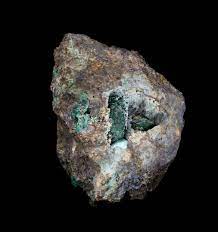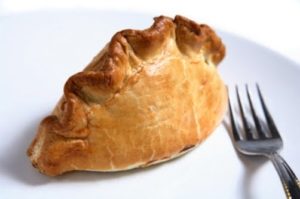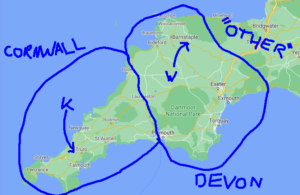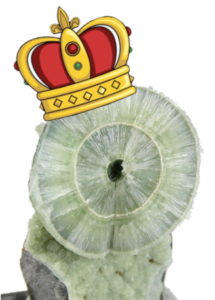
Kernowite: In November 2020, approximately two major world events occurred. Firstly, Joseph R. Biden Jr. and his dog Major were elected as the 46th president and president’s dog of the United States of America. Secondly, the International Mineralogical Association approved a new mineral, kernowite, Cu2Fe3+(AsO4)(OH)4⋅4H2O, which was described by M. Rumsey from the Natural History Museum in London. The sample came from a now abandoned mine in Cornwall, a county in the South West of the UK (the sticky-out bit at the bottom left), and the name ‘kernowite’ comes from the name of Cornwall in the Cornish language, Kernow.
Pointless rivalries: Right next to Cornwall, on the South West Peninsula of the UK, sits another county, Devon. Over the years many debates and rivalries have popped up between these two counties, the most famous being the origin of the pasty (pronouced ‘pa-stee’ not ‘pay-stee’) – a meal where meat and vegetables are wrapped up in a pastry shell and baked. The Cornish (people from Cornwall) claim to be the original inventors, the Devonians (people from Devon) claim the same.
As a proud Devonian myself, I can say without any bias that the pasty was certainly invented in Devon – if it is written , it must be true. The other is the origin and correct way to eat a cream tea, basically a scone (~biscuit for the Americans) with cream and jam. In Devon, cream goes on before jam, in Cornwall, jam before cream. This debate was finally settled when it was revealed that the Queen follows the Cornish method , then, given the obvious logic that everything the British royal family does must be wrong, the Devon method has to be correct.
Devonian and Cornish minerals: The addition of kernowite represents a clear attempt by the Cornish deep state to salvage some respect by one-upping Devon (in mineral terms). So we have to ask the question, did it work? Unfortunately the mineral ‘devonite’ was first found in Missouri USA, so isn’t much use here. But, Devon has three of its own minerals, all first described in Devon (the type-localities are in Devon) – wavellite, childrenite and chrisstanleyite. So, to settle the Devon vs. Cornwall rivalry once and for all, let’s do a totally unbiased* (*not guaranteed) comparison between wavellite (Al3(PO4)2(OH,F)3 · 5H2O) a proudly Devonian mineral, and kernowite, some other mineral.
Wavellite vs. kernowite top trumps: In the following, I will rank the two minerals in a series of randomly chosen categories, each of which has 1 point up for grabs. Whichever gets more points wins, it’s as simple as that.
- Number of H2O molecules in the structural formulae: kernowite: 4, wavellite: 5. Wavellite wins! (why is this important? simple, wetter = better)
- Least amount of copper in formulae: kernowite: some copper. wavellite: no copper. Wavellite wins again! (why is this important: copper mining is often highly damaging to the local environment, so copper-bearing minerals are more likely to contribute to environmental problems)
- Highest degree of symmetry in the crystal structure: wavellite: orthorhombic. kernowite: monoclinic. Wavellite continues its winning streak! (why/what? orthorhombic minerals have three mutually perpendicular axes, monoclinic minerals have two inclined axes, one perpendicular axis. The former is much more useful for people wanting to make a dice out of a mineral specimen, which is obviously loads of people)
- Hardness: As far as I know, no hardness data is published for kernowite (uh oh), but it is probably around 2-2.5 on the Mohs scale, based on information about liroconite, which is isotructural. Wavellite is 3.5-4. What?? Wavellite wins again! (why is this important? harder minerals are more likely to withstand a vicious attack from fingernails (hardness 2.5)).
- Largest unit cell: kernowite: ~780 cubic angstroms. wavellite: 1170. This is just getting embarrassing, another win for wavellite! (what/why? the unit cell is the smallest group of atoms that can build the whole crystal structure by repeating in three dimensions. A larger unit cell means that a given volume will have fewer unit cells, therefore anyone given the task of counting unit cells will have a much easier time).
- Most recent description? Kernowite: 2020, wavellite 1805. Well, kernowite had to win something.
- Name most related to an actual human person? Kernowite was named after an area (Cornwall) whereas wavellite was named after William Wavell, who was, as far as I know, a person. Wavellite takes another victory! (why is this important? I don’t know, why not)
Final score: wavellite: 6, kernowite: 1. Unfortunately, whilst kernowite was widely reported in the media at the end of 2020, it just cannot compete in a series of unbiased* (*not guaranteed) questions when pitted against a humble mineral from Devon. Sorry Cornwall.





